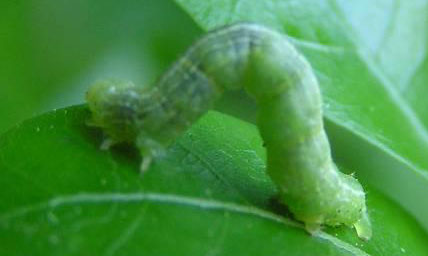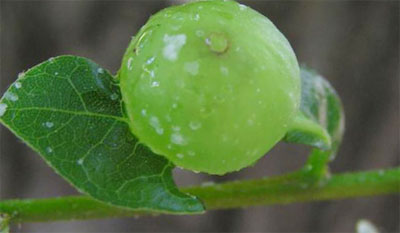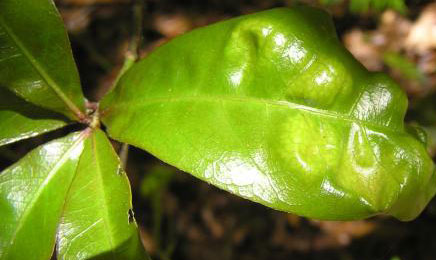Unusual And Entertaining Sights Found In Local Oak Trees
May 15, 2010
 Local oak trees are putting on a show this year. Loaded with thousands of flower tassels or catkins, some say that the pollen is as bad as they have seen. Look closely however, and you’ll see more than just a pollen-laden tree.
Local oak trees are putting on a show this year. Loaded with thousands of flower tassels or catkins, some say that the pollen is as bad as they have seen. Look closely however, and you’ll see more than just a pollen-laden tree.
Green acrobatic caterpillars
If you’ve been walking or raking under local oaks, then you’ve probably noticed the small green caterpillars performing acrobatic moves on thin whips of silken thread. If you haven’t noticed them, then probably someone has had to pick a caterpillar off your shirt or out of your hair.
Hundreds of these little caterpillars are hanging from panhandle oaks. What are they? While many will call them inchworms after their characteristic looping gait, they are technically called oak leafrollers.
 Oak leafrollers are the larval forms of an earthy-colored moth. The moth lays masses of 40 to 50 eggs at the base of large branches and rough bark patches on both tree trunks and limbs. These eggs begin hatching in early spring and the caterpillars begin eating the leaves.
Oak leafrollers are the larval forms of an earthy-colored moth. The moth lays masses of 40 to 50 eggs at the base of large branches and rough bark patches on both tree trunks and limbs. These eggs begin hatching in early spring and the caterpillars begin eating the leaves.
While they can eat an abundance of oak leaves, don’t worry. A little defoliation will not seriously harm a large oak tree.
Galls galore
Abnormally large round growths can be seen on many leaves of local oaks. These swellings are known as galls. While a variety of living organisms, including insects, mites, bacteria, and fungi are capable of causing galls, oak galls are typically caused by insects called gall wasps.
 The tiny gall wasp begins the gall making process in early spring by piercing a selected tree part with its egg laying device and depositing an egg inside the plant tissue. Fluids deposited with the egg cause the plant cell multiplication process to begin. The larva that hatches from the egg produces additional substances that maintain and control cell division. The larva develops within a cavity inside the gall, feeding on material produced in the cavity lining. At maturity, the larva transforms into a pupa, and later becomes an adult that chews its way out of the gall. By causing the tree to form a gall, the gall wasp has provided food and shelter for its offspring.
The tiny gall wasp begins the gall making process in early spring by piercing a selected tree part with its egg laying device and depositing an egg inside the plant tissue. Fluids deposited with the egg cause the plant cell multiplication process to begin. The larva that hatches from the egg produces additional substances that maintain and control cell division. The larva develops within a cavity inside the gall, feeding on material produced in the cavity lining. At maturity, the larva transforms into a pupa, and later becomes an adult that chews its way out of the gall. By causing the tree to form a gall, the gall wasp has provided food and shelter for its offspring.
Most galls are not harmful to oak trees. A healthy tree can support numerous galls without being seriously harmed.
Blisters erupt
If the caterpillars and gall wasps aren’t enough, a disease is also causing some unattractive leaves on local oaks.
Oak leaf blister is caused by a fungus. Early in the spring as leaves begin to expand, the fungus causes small, rough (concave, convex) spots. Gradually, the spots thicken and become pale green in color. Older spots are generally brown to greenish brown. Several blisters may merge, forcing the leaf to curl and can cause premature defoliation.
 Because the oak leaf blister does not seriously affect the overall health of the tree, chemical control measures are usually not recommended. Collecting and disposing of the leaves as they drop may be of some benefit in reducing the inoculum for the following spring.
Because the oak leaf blister does not seriously affect the overall health of the tree, chemical control measures are usually not recommended. Collecting and disposing of the leaves as they drop may be of some benefit in reducing the inoculum for the following spring.
Local oaks are offering several interesting sights. All of the above issues will typically only cause leaves to look strange or unattractive. The trees themselves are not usually harmed by these strange and entertaining sights.
For more information, contact Theresa Friday at 850-623-3868 or email tlfriday@ufl.edu. Friday is the Residential Horticulture Extension Agent for Santa Rosa County.
Courtesy photos by Theresa Friday for NorthEscambia.com, click to enlarge.
Comments
5 Responses to “Unusual And Entertaining Sights Found In Local Oak Trees”



eat small fish
Their too little for fish bait, aren’t they? Plus their cute! =).
REGARDING:
‘While they can eat an abundance of oak leaves, don’t worry. A little defoliation will not seriously harm a large oak tree.’
But the real question is: How do they compare to catawba worms for fish bait?
good article, I enjoyed it
Very interesting. Some things I’ve wondered about. Thank you.
Thank you for all that info. It will save me/us from a lot of fretting. We lost a lot of trees from hurricanes & tornadoes & don’t want to lose anymore.